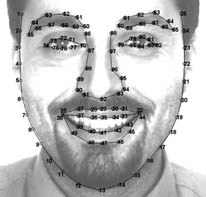Nov 4 2009
Recognition techniques based on facial features, known as facial biometrics, is usually based on the search for those traits which make one face different from another.
The research carried out by this team, in contrast, approaches the issue from a slightly different point of view. “The difference between our work and the majority of the others that are found in this field is the idea of individualized models.”, explains one of the study’s authors, mathematician David Delgado Gomez from the UC3M Statistics Department. “Our objective”, he continued, “is to create a model for each person which highlights the most distinguishing features of each face, as a sort of facial “DNI”.
 Facial Biometric
Facial Biometric
The researchers had this idea when they were imagining the situation of a crowded room where someone comes in asking for one of them. “Our way to describe a person is through some traits that the others don’t have, such as the tall woman with blue eyes, or the bald guy with a beard. We try to apply this idea to our algorithm.”, remarked Professor Delgado, who has been carrying out this research with Federico Sukno, Kaushik Pavani and Alejandro Frangi from the CISTIB Group of Universidad Pompeu Fabra of Barcelona, and Bjarne Ersboll and Jens Fagertun from the mathematical modelling group of Technical University of Denmark, which has recently published an article entitled “Similarity-based Fisherfaces”, with some of their research results appearing in the scientific journal Pattern Recognition Letters.
Basic elements
A facial biometrics system is normally made up of three components. First, a camera is necessary to record an image; secondly, a software program is needed which determines if there is a face in that image, locating among other things, the facial geometry (the placement of the eyes, nose, mouth, etc.); and thirdly, a system that is capable of classifying all those elements to differentiate between them and those of other persons. The most complicated part, according to the researchers was combining the facial geometry and facial texture. “With only the geometric information, very low classifications are obtained, which is why we combine this information with that of facial texture to obtain a more robust model, and a statistical way of combining them occurred to us, which offered very good results.”, Delgado pointed out. The researchers have shown that when this system is used in a controlled environment, it can achieve a 95% rate of precision.
The main complication occurring when using this type of systems is the lighting, which can change the color of the face. Another challenge is the passage of time, because as a person ages, his/her face undergoes changes as it becomes heavier, thinner, or more wrinkled, which can then fool the classifiers. On the other hand, the researchers add, it does have a significant advantage when compared to other biometric systems: it doesn’t need direct interaction with a person as do fingerprinting or iris recognition, for example.